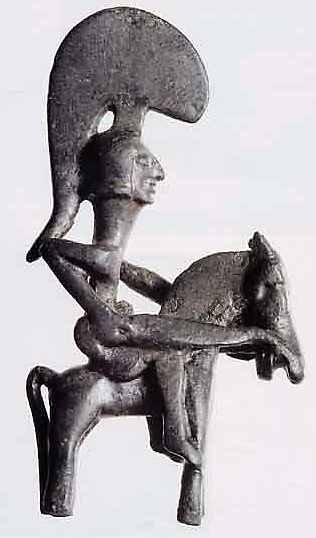The Gallic Celts who settled in Spain and mingled among the natives to create the Iberian culture changed very little about their culture in comparison to the Gauls who settled in modern-day France. So, rather than pick through the minutiae of differences between them and their north-eastern neighbors, I will give a short summary of their history and importance before showing several interesting pictures to display some of the more brilliant and unique aspects of the Iberian peoples.
The city of Gadiz was founded in 1104 BCE, according to tradition, and is therefore the oldest continually inhabited city in Western Europe. Its people were Phoenician colonists originally, but over time its population grew to include some local tribes who decided to give up nomadic herding for urban life. This seems to be a trend among the Gauls worldwide, that they eventually decide to build settlements instead of continuing to roam. The Phoenician-Iberian-Celts did very well for themselves, and Gadiz as well as other Spanish settlements became some of Carthage's most prosperous colonies. That's not to say that it was all fuzzy hugs with the Carthaginians; securing their cities from raiding tribes who were competing for resources meant conquering much of Spain, ensuring a healthy supply line for continued prosperity.
The Carthaginians were notorious for farming their wars out to mercenaries. Carthaginian soldiers would form the main line of their army, but they lacked the martial culture of Rome or even their more ancient colonists in Palestine (which you may know as the Philistines). They were much more interested in trade than war, so when war came about, they hired the mercenaries they needed to pursue their military agenda. The Iberian tribes which continued to live outside of Phoenician hegemony were offered a deal during the Second Punic War: fight for us and gain spoils and honest pay. However, try as he might, Hannibal did not have the logistical support necessary to successfully subdue Rome and the Second Punic War ended Carthaginian control over Iberia as part of the terms of peace. The Romans set up shop and used the massive, underpopulated region as their bread basket and plentiful source of metal.
This sword is called a falcata, and its weight is distributed in such a way that swinging it creates the same force and impact as swinging a larger battle axe. It dates to the 4th Century BCE.
The most useful of their weapons was adopted by the Romans around the 300's BCE and utilized more heavily in their army after the Second Punic War. The Iberian version of this sword was around 5 feet long, which the Romans shortened to 2-3 feet for the practical purpose of stabbing someone by going around their shield
And lastly, this little bronze statue shows an Iberian knight on his horse, gladius in hand and plumed helmet looking very Greek. Clearly the Iberians had an equestrian class capable of purchasing and maintaining horses, indicating some level of class structure.
The Iberian peoples were Romanized at the first available opportunity, and lost most of their connections to the culture of the Gauls, who would not be conquered until Julius Caesar put an end to them once and for all in 50 BCE.
Pax vobiscum

_01.jpg)
-Segunda_Edad_del_Hierro.jpg)

No comments:
Post a Comment